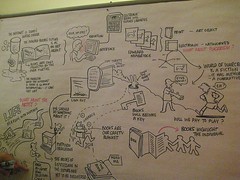
- Image by Annie Mole via Flickr
The phenomenon of social reading is not new, but now in the era of Web 2.0 it is being discussed in a different way. Casual conversations about books are being moved to the Web (which requires difficult technical development to capture the way humans actually communicate with one another), where it could potentially blossom into something richer.
Nor is it lost on publishers with foresight that social reading may have important implications for monetization.
This is good news for the book business (good news for the book business? I must be crazy), which is now sleepless as it ponders the potential loss of bricks-and-mortar bookshops in the face of e-books and Amazon, the Tyrannosaurus Texts of the publishing industry.
Social reading refers to all the conversations and commentary that take place outside a text, but making reference to a text. Your reading group that meets over finger food and white wine to discuss Jodi Picoult or (it could happen) Montaigne or Gibbon is participating in a form of social reading. Online, social reading takes many forms, from reviews posted on Amazon to bona fide reading groups to comments placed alongside a work.
What is the best way to think about all these incarnations of social reading?
Bob Stein has proposed a taxonomy, which I will call The Stein Taxonomy, at his blog for the Institute for the Future of the Book. Stein has identified several categories of social reading, depending on whether they are online or off, synchronous or asynchronous, formal or informal. There is a thesis attached to this — social reading is as much a part of a work as the text of the work itself. Perhaps this is arguable — but to argue the point is to engage in a form of social reading, which perhaps serves to prove Stein’s point. Interestingly, Stein’s essay is published using software called CommentPress, which permits readers to place comments in the margins of the piece. So we have a taxonomy of social reading placed within a context of social reading on a platform designed for social reading. And, I suppose, the post I am writing right here is part of that social reading experience as well.
I don’t have any quarrel with the outline of the Stein Taxonomy, but I do wish to note that it defines social reading along a single axis, that of the social dimension of social reading itself. This is to say that the Stein Taxonomy is very much a social taxonomy. It is not hard to imagine social reading being viewed analytically along different lines. For example, what are the economic implications of each category of social reading? Or how about the technological implications; what would be the taxonomy for that? For every perspective, there potentially is a taxonomy. This doesn’t make the social approach to social reading any less important; it simply means that it has company.
A curious thing developed since the Stein Taxonomy was posted. A typical debate about it broke out on Peter Brantley’s Read 2.0 mailgroup (which is private and hence I am not providing a link). Bob Stein, a member of the Read 2.0 group, urged the list to post their comments to the blog at the Institute for the Future of the Book using the CommentPress software, but to no avail — the argument went on, without a direct link to the original text. This perhaps tells us something about another aspect of social reading — it must be anchored in a community first. How to create such communities is another, and much bigger, matter.
Discussion
6 Thoughts on "The Stein Taxonomy: An Analytic Model for Social Reading"
If it’s happening in an asynchronous manner, can it really be called a “conversation” or a “discussion”? This reminds me of a post I wrote a while back, about shelf-life of content, and how the longer the shelf-life, the lower the participation value. Monday night’s football game is an ephemeral event–if people are going to talk about it, almost all are going to talk about it Monday night or Tuesday morning. “The Sun Also Rises”, however, has been read and is being read by different people over a long period of time. There’s less immediate time pressure driving the participation, and those who want to discuss it may be reading it decades apart. If I write my thoughts about the book in the margin of an online copy, it’s pretty unlikely that I’m going to respond to someone else’s comments left 4 or 5 years from now. I’ll be reading something else by then.
Instead of a conversation, it’s more akin to reading the graffiti left on the wall by previous visitors. This is important in thinking about commenting systems for scientific papers. It’s not the same thing as an online chat, and is more like annotation. It’s “social” in the sense that anyone can participate, but it’s not “social” in the sense that there may not be any direct interaction between people.
Hmm, what about a wiki article though? How different is an annotated work as described above from a wiki article? I’m thinking about the physical version of the wikipedia article on the Iraq war as I type this. Fascinating to study the evolution of the article as seen through the lens of the multiple points of view and the edits and comments and additions/subtractions that occurred. If you follow my thoughts, then that would indicate that perhaps there is a long term life for particular instances of content.
There’s no doubt that there’s long term life for this type of content. I may just be quibbling over semantics though, on the use of “conversation” as the term. Perhaps the back and forth in the comments and edits could be seen as such, but the Wiki article itself is a different form of communication, one with fairly rigid rules and overseen by a strict hierarchy.
None of which means the comments are without lasting value.
From a scholarly perspective, asynchronicity/synchonicity doesn’t have much of an impact on whether something is a conversation. The real question is whether or not the comments/writing address each other.
There’s little doubt, I think, that a discussion/conversation can happen over email or here within an asynchronous comment form (look at the semantics of this box as “Leave a reply.”
So from that perspective, social reading (in which you are engaging in a dialog over asynchronous postings/annotations) can still potentially be a discussion. The real question is how and if the different posts interact.
Again, I may just be making a semantic argument, but I think of “conversation” as being a back-and-forth dialogue (or including more than 2 participants). If I write a comment, then 5 years later someone responds, and I never go back, never see that response, never respond to it, am I engaging in a “conversation”?
This article, if it follows the form of most on TSK, will have a comments over the course of a week or so after its out, then will sit idle. Perhaps someone will come along next year and add another opinion. If we don’t see it, is it still a “conversation”?
Maybe there’s a better way to describe this sort of asynchronous interaction.
A curious thing developed since the Stein Taxonomy was posted… the argument went on, without a direct link to the original text. This perhaps tells us something about another aspect of social reading — it must be anchored in a community first. How to create such communities is another, and much bigger, matter.
Joe, I take the “on-list” versus “within the text” discussion of the taxonomy and social reading in a slightly different way. As I’ve shared with Bob both on the list and at the comment-press site, one thing that I think is missing from his current taxonomy is an attention to *how the text is being used* within the discussion.
In community experiments at Kodak.com during the late 90’s & early 2000’s we learned that understanding that relationship between text and talk was a critical component to knowing what conversations will take place and where. So for example, discussions on photography that centered on photography (equipment, technique, tips, etc) would happen at Kodak.com. Discussions about photography that centered on subjects (babies, pets, etc) were far more likely to take place on sites dedicated to those specific topics. The reason for this is that photography was a support in these conversations, rather than the focus.
In much the same way, I’d argue that most of the discussion that took place on the list wasn’t really about Bob’s taxonomy, but using that as a starting point to discuss the overall concept of social reading. Looking at it from that perspective, trying to force the discussion to take place on the text would be a case of missing the forest in an attempt to restrict things to a single tree.
I think that this points to a potential shortcoming of the “in text” model and reinforces the need to develop a universal standard for tagging and aggregating these conversations/discussions.



